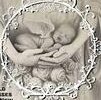MINNEAPOLIS — When a labor and delivery nurse saw a wedding dress at the Empty the Nest thrift store in Golden Valley, she knew it was going to hold a much greater purpose than its original wearer had ever imagined. The gown would be re-purposed into a special burial dress for a baby that never had the chance to live. The idea resonated with Tess Soholt, who lost her own infant son at 18 weeks gestation while working as a labor and delivery nurse. The loss pulled on her heartstrings so hard, that she began a new chapter of her life, launching Little Angel Gowns SW MI last year.
The nonprofit organization partners with hospitals and birth centers to provide families whose babies are stillborn or die shortly after birth, with gowns and outfits made from repurposed wedding dresses. The organization has a volunteer network that spans the country.
Each angel gown and outfit is stitched by a seamstress who has been personally touched by the loss of an infant or child. Some of the group’s 66 seamstresses, including Pat Marsters of Pembroke, lost children of their own, while others have been touched by the loss of loved ones or friends.
In addition to the small gowns, the group also creates hats and sleep sacks for those who may prefer something less traditional. They’ve even designed a pattern for overalls to be used as burial suits for stillborn or premature babies, who might be too large for a small gown. “Our goal is to bring dignity to the short lives of these precious babies,” Marsters says.
She adds that she feels a connection to the work because she was a patient at Akron Children’s when her daughter passed away. She also has a personal connection to her group’s partner hospital, Northridge Hospital in Long Beach. It was the first facility to receive a package of angel gowns and has been named their hospital of the month for July 2023.
Soholt has been a volunteer seamstress since last summer and makes four gowns at a time. She encourages anyone who wants to learn how to make the garments to join her Monday afternoons at the thrift shop, where she conducts a training session. During that time she deconstructs a wedding dress and discusses the different patterns for the gowns. She also makes sure everyone is comfortable with using a sewing machine.
Those who want to help make the gowns can bring a sewing machine, and scissors or pins. They can also sign up on the website of the Minnesota group for an upcoming training session.
The group accepts dresses from across the state, and they can also be donated online. The wedding dresses are cleaned, cut and sewed into the angel gowns and other outfits, which are then handed out to grieving parents. The group hopes to reach more families, but currently they’re supplying a few dozen per month to local hospitals.
